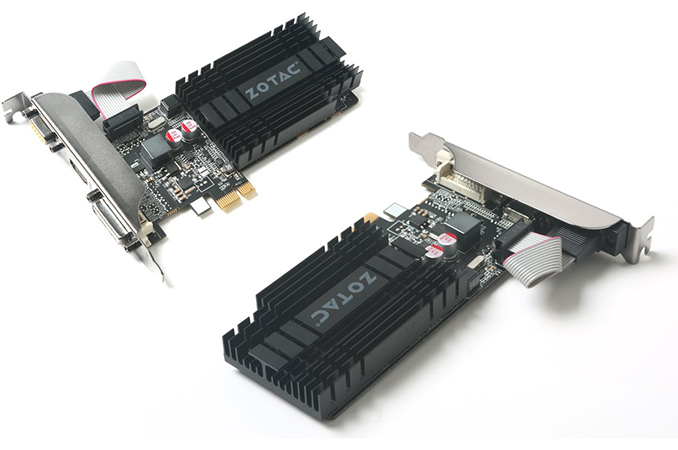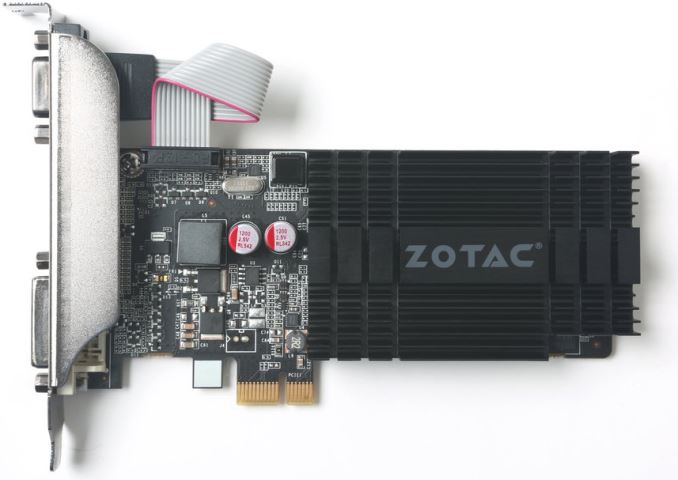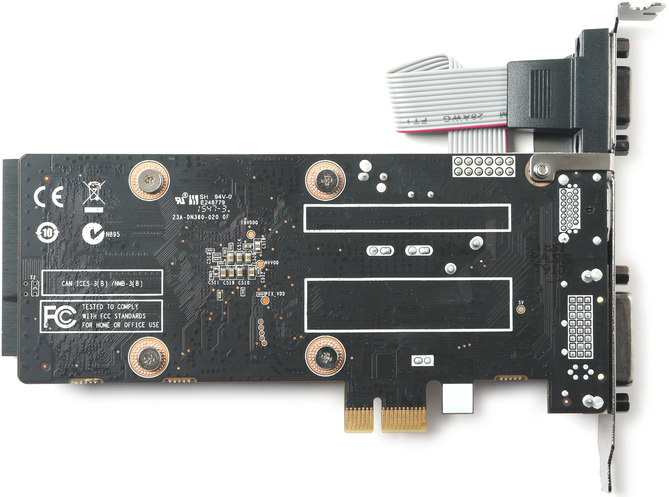ZOTAC Quietly Releases GeForce GT 710 Graphics Card with PCIe x1 Interface
by Anton Shilov on April 22, 2016 10:00 AM EST
ZOTAC has quietly introduced a new video card which is compatible with virtually every desktop PC released in the recent years. The new GeForce GT 710 graphics card with PCIe 3.0 x1 interface is not going to outperform modern higher-end iGPUs in games, but it will help owners of very low-cost systems, particularly those which may not even have a PCIe x16 slot, to add support for another display, or improve over the performance of completely outdated iGPUs.
The ZOTAC GeForce GT 710 1 GB (ZT-71304-20L) video card is powered by a cut-down version of NVIDIA’s GK208 GPU with 192 CUDA cores, 16 texture units and 8 ROPs. The GPU is based on the Kepler architecture, which supports Direct3D feature level 11_0, OpenGL 4.5 as well as OpenCL 1.2 APIs. The chip is clocked at 954 MHz and has compute performance of around 366 GFLOPS (well below that of modern iGPUs). The card is equipped with 1 GB of DDR3-1600 memory featuring 12.8 GB/s bandwidth.
The card comes in half height half length (HHHL) form-factor and is shipped with two brackets (for low-profile and standard PCs) to maximize compatibility with various computers. The graphics board has minimal (19W) power consumption and does not require active cooling (which means, it is also whisper quiet).
The main selling points of the ZOTAC GT 710 are its PCIe 3.0 x1 interface as well as three display outputs — DVI, HDMI 1.4 and D-Sub. Some entry-level PCs simply do not have PCIe x16 or x8 slots to install a graphics card, but virtually all desktops released in the last ten years have at least one PCIe x1 slot. ZOTAC’s new graphics card promises to be compatible with such systems. If owners of such PCs need to add one or two more display outputs, or just find their iGPUs too slow in Windows 10, they can buy the GeForce GT 710 1 GB PCIe 3.0 x1 graphics adapter. The board supports up to three displays, which should be enough for many workloads.
| NVIDIA GPU Specification Comparison | ||||||
| GT 710 | GT 720 | GT 630 | GT 610 | |||
| CUDA Cores | 192 | 192 | 192 | 48 | ||
| Texture Units | 16 | 16 | 16 | 8 | ||
| ROPs | 8 | 8 | 16 | 4 | ||
| Core Clock | 954MHz | 797MHz | 875MHz | 710MHz | ||
| Shader Clock | N/A | N/A | N/A | 1620MHz | ||
| Memory Clock | 1.8GHz DDR3 | 1.8GHz DDR3/ 5GHz GDDR5 | 1.8GHz DDR3 | 1.8GHz DDR3 | ||
| Memory Bus Width | 64-bit | 64-bit | 64-bit | 64-bit | ||
| VRAM | 1GB or 2GB | 1GB or 2GB | 1GB or 2GB | 1GB | ||
| TDP | 19W | 19W | 50W | 29W | ||
| GPU | GK208 | GK208 | GK107 | GF119 | ||
| Launch Timeframe | January, 2016 | March, 2014 | April, 2012 | May, 2012 | ||
| Launch Price | $30 - $50 | $49 | OEM | $49 | ||
When it comes to performance in games, it is unlikely that the GeForce GT 710 is fast enough for more or less demanding titles. The product may be faster than iGPUs integrated into entry-level Celeron or Pentium processors, but only in various online games that do not require a lot of GPU horsepower anyway.
As for market perspectives of ZOTAC’s GeForce GT 710 1 GB PCIe 3.0 x1, it should be noted that this is a niche product designed for owners of low-end systems, who need a better GPU or additional display outputs. Typically, people, who use such systems do not upgrade often, hence, ZOTAC’s new video card will hardly become a bestseller. Nonetheless, it will be a unique device for those who really need it.
ZOTAC does not list recommended prices on its web-site. However two stores which sell the device in Europe have it listed €58.30 ($65.8) and €84.7 ($95). This is definitely higher than you'd otherwise expect for a bottom-tier NVIDIA card, though it may very well be that retailers are counting on its unique nature.
Source: ZOTAC (via the Tech Report)

















55 Comments
View All Comments
QuantumPion - Friday, April 22, 2016 - link
lol what? If someone has a < $1000 4k TV they probably don't want to spend $300 more on just a video card just to output 4k. And the idea of putting a high end, high power gaming card in a mini ITX media enclosure only used for watching streaming 4k content is absurd. Many people use HTPC's to save money vs. consumer media players. There are still no cheap HDMI 2.0 video cards that I am aware of.JeffFlanagan - Friday, April 22, 2016 - link
I point out that you're incorrect, and your response is "lol, what>" I should know better than to respond to people who aren't making any sense.For your post to seem to make any sense, one has to mistake a 4K TV for a home theater, and assume that most people with home theaters don't game. 4K projectors are still very expensive, so most of us do still have 1080p home theaters, with the 4K TV in the living room.
Samus - Sunday, April 24, 2016 - link
People don't need to spend $300 for 4K unless they gaming. For HTPC you would need no more than a 3 year old 750Ti.abhaxus - Friday, April 22, 2016 - link
one excellent use for such a card is in a server. I have an FX8320 based server at home that has no iGPU. I use all of my PCIe 16x slots (quad gigabit NIC, 10 GBe NIC, SAS card, and SAS expander). I use an AMD PCIe 1x card for console output.bill.rookard - Friday, April 22, 2016 - link
Exactly. I have an Asus 2U rackmount and the standard VGA was soooo pathetically slow as to be near useless. I dropped a GT630 based card in there (25w TDP) and it's no comparison. Plus, the higher TDP cards require the PEG power connectors which sometimes aren't available in a server based power supply.But as you mentioned, these work perfectly well in these circumstances.
JeffFlanagan - Friday, April 22, 2016 - link
Can this be used as a Physx card? If so, a lot of mid-range game machines have a spare x1 slot available.BrokenCrayons - Friday, April 22, 2016 - link
Based on the PhysX FAQ on NV's site (http://www.nvidia.com/object/physx_faq.html#q3) it looks like this GPU meets the fairly modest minimum requirements easily. In summary, you need an 8-series GeForce (think 8800 GTS era) with at least 32 cores, and at least 256MB of VRAM.I think my only question though is whether or not there are enough PhysX titles out there and if dedicating a GPU to PhysX would make it worth doing. I was under the possibly mistaken impression that there weren't a lot of PhysX games in the wild.
hansmuff - Friday, April 22, 2016 - link
There are a bunch of considerations about your question. So first off, this should work, yes.Here's a decent article on the matter: http://www.volnapc.com/all-posts/how-much-differen...
They used a GTX 650 as the Physx card, and if I see this correctly the GT710 will be quite a bit slower. It would be a very cool test to do.
The other consideration is games, and which use PhysX:
http://www.geforce.com/hardware/technology/physx/g...
If you play those a lot, I would definitely give it a shot. The card is cheap enough.
fazalmajid - Friday, April 22, 2016 - link
Thèse cardes coule also BE use full for peuple who are trains to drive massive Numbers of monitors lime digital signage where performance si notre critical.fanofanand - Friday, April 22, 2016 - link
Throughout the article x4 and x1 are interchangeably used. Was this designed for x1 or x4? Seems with the low performance and bandwidth it wouldn't need more than x1, but the very first paragraph says "The new GeForce GT 710 graphics card with PCIe 3.0 x4 interface is not going to outperform modern higher-end iGPUs in games, but it will help owners of very low-cost systems" Scroll a little further and it says "The main selling points of the ZOTAC GT 710 are its PCIe 3.0 x1 interface". So which is it?